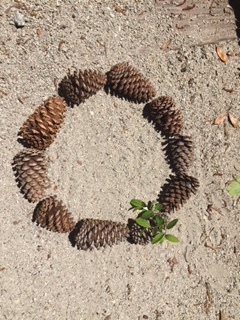The celebration of Thanksgiving with a traditional dinner comes alive in thoughts of a past era of my life—a polished curly birch table (in later years, a teak table), a center bowl of autumn gourds, roast turkey on a large platter with a pitcher of pan gravy to pour over the chopped celery and sage stuffing, the mashed potatoes, and the turkey. On the side is the baked acorn squash with brown sugar melted into the golden orange bowls of its halves, crunchy string beans, whole black olives, and ruby red cranberries, placed whole or as sauce in a round crystal bowl or as juice in crystal goblets. For dessert, warm apple and pumpkin pies, with real whipped cream melting on the top of each piece. My holiday images are safely stored in a small purse of memories of earlier family arrangements around different tables in different towns, yet all with the holidays lingering into days of turkey sandwiches and turkey soup.
This year, it is only the ruby red cranberries, one of the three native fruits of New England, that have captured my imagination With that comes my wishful thought that I’d made it a point to watch cranberries being harvested. At least, I’ve now seen an image of the rich, red, nubby carpet of a cranberry bog being harvested—a mind-boggling view!*
It was in the summer weeks on Cape Cod, part of southeastern Massachusetts, that I first saw a cranberry bog. I was unimpressed. How are cranberries grown here? What I was seeing looked like flattened, dried grasses (yet, I was driving somewhere and felt that I couldn’t stop for a longer look). But remembering as I write today, I think that the low-lying, berried vines were there; I just didn’t know what to look for.
Glacial deposits laid in more than ten thousand years ago are the origin of bogs (or marshes), where a special combination of beds layered with sand, peat, gravel, and clay provides a surface for the low-lying cranberry vines to grow on. “Some vines on Cape Cod are more than 150 years old and are still bearing fruit.”* Then, as the berries become “well-colored,” they are harvested.
Cranberries have pockets of air inside the fruit. Because of this, cranberries float in water, and thus, the bogs can be flooded to aid in removal of fruit from the vines. Water reels . . . stir up the water in the bogs. . . .[C]ranberries are dislodged from the vines and float to the surface of the water. Wooden or plastic “booms” . . . round up the berries, which are then lifted by conveyor or pumped into a truck to take them … for cleaning. More than 90% of the crop is wet harvested.*
The cranberry growing season begins in April and ends by November as the berries must lie dormant in chilly weather to produce again next spring.
My realization is, “Life recycles unique memories that may be more than pleasurable—they may also spark new learning.”
* https://www.tripsavvy.com/the-best-cranberry-bogs-to-visit-in-massachusetts-4153088
* Annies Crannies, https://www.cranberries.org/visit
* https://www.cranberries.org/how-cranberries-grow


